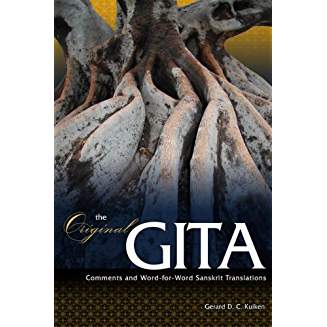
The Original Gita
Review
Most readers will be familiar with the Bhagavad Gita but will find new depth of analysis and insight in this translation and commentary. The author is a scientist who has studied yoga for over 50 years, describing the Gita as a discussion on the science and spirituality of life reflected in the various paths of 'striving for Oneness'. There are three fascinating essays in the beginning of the book, on thought, time and the relationship between life and death. These essays propose that 'without a limitation there is no existence' and that the brain is the tool for setting up limitations and controlling the consciousness of differences. In this way, 'man becomes aware of himself by limitation and experiences that as the awakening of his own world.' The second essay on time proposes that 'time is part of the form world and that the formless world is timeless', a formulation corresponding to insights from near-death and mystical experience. This leads to the third essay, which argues that life and death are complementary in the sense that 'in life, spirit is beyond space-time and substance is in space-time', while in the unseen world 'substance is beyond space-time and spirit is in space-time -- the inside thought is seen as the outside world.' In other words life is turned to the outside and death to the inside. These are profound reflections and are elaborated in the commentary on the text. All students of the perennial wisdom and the Gita will want to make a careful study of this book. David Lorimer: Network Review, Journal of the Scientific and Medical Network. No. 104, Winter 2010, p. 67.
Description
The Original Gita presents the essence of the Mahabharata Bhagavad Gita, together with an introduction and an explanation of Eastern thought and the spirituality information it contains. Comparisons with the Bhagavad Gita give you the opportunity to realize for yourself the interpolations that have occurred in the course of time. For example, the caste system was introduced by changing the verse BG4.13 [in the Bhagavad Gita] a little and adding a number of interpolated verses.
Part One explains that differences are always involved in our concepts and thinking, resulting from limitations. The consequences of this basic process are discussed in the chapters about space-time and life-death. The introductory chapters provide a basis for understanding existence. Here, also a basic understanding of the Bhagavad Gita can be obtained.
Part Two presents stanzas of the Original Gita without comments. The 209 verses of the Original Gita correspond to 319 verses in the Bhagavad Gita. These 319 verses can be considered as the core of the Bhagavad Gita; the remaining verses have been added.
Part Three contains a word-for-word translation of the Sanskrit words of the core 319 verses of the total 700 verses of the Bhagavad Gita. Comments are given on all the Original Gita verses. Included is a mini Sanskrit-English dictionary.